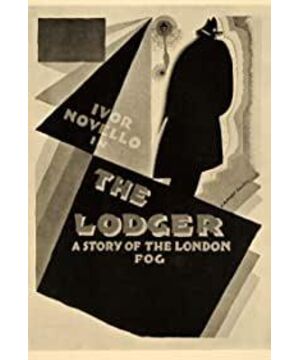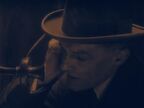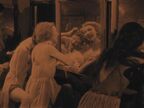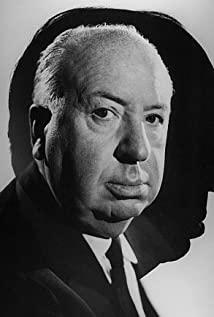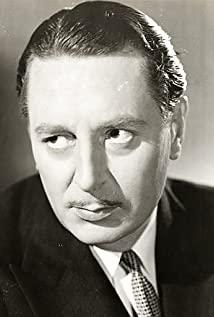This article was first published on the self-media subscription number "kaiweimovie"
Hitchcock's mature work has been talked about a lot, and today I'm going to talk about his early silent film " The lodger " and its behind-the-scenes story.
Before Hitchcock directed his first film, he worked at Neubabelsberg Studios on the outskirts of Berlin, Germany. There, he can see the on-site work of the famous German film director Fritz Lang (whose masterpiece "Metropolis" was filmed here) and the director of FW Murnau
In London, Hitchcock often watched screenings of the latest Soviet films at the Film Society Cinema on Regent Street , and he brought his experience of visiting German studios and watching Soviet films into The Tenant. .
In the silent era, he has created in his films, in addition to the dramatic scenes, unexpected shooting angles, and subtlety in editing, so that his films often look more like a German or Soviet A film, not a serious, poised British film.
When the film premiered in 1926, it was a resounding success, with Film Screening magazine proclaiming: "This film is arguably the finest British work ever produced."
After the film's release, the 27-year-old Hitchcock's reputation as a director was firmly established. As Hitchcock said to French New Wave director Truffaut: " It was the first time I practiced my style ."
What did Hitchcock learn from his partners? The silent-era film has begun to show Hitchcock's penchant for suspenseful stories. Of the Hitchcock films that preceded 1934's "The Killing," he himself loved The Tenant, calling himself "the first true Hitchcock film."
The film is based on the 1913 novel of the same name by author Marie Belloc Lowndes, a prolific writer who had a younger brother named Hilaire Belloc, also a famous writer .
In London in 1888, the notorious " Murder Case of Jack the Ripper " shocked the world and became a mysterious and unsolved case with far-reaching influence. So far, there are special websites to talk about this case, and various movie remakes emerge one after another, extending all kinds of new stories. and topic. At that time, the inspiration for Landis to write this novel was also influenced by this story.
In this way, Hitchcock, who adapted Landis' novels, is also an early film director involved in the "Jack the Ripper" story. For this adaptation, he wrote the script together with his old partner Eliot Stannard.
Among the silent films shot by Hitchcock, except "The Ring" ( The Ring ), which was signed alone, the others were completed with Stannard. But the film is said to have had Stannard's contributions in the first place as well.
In fact, insiders know that Hitchcock is notoriously stingy when it comes to evaluating his collaborators, and many people have found that in the French director François Truffaut (Franois Truffaut) Hitchcock was notoriously stingy. In Kirk's lengthy interview, Stannard was never mentioned.
The performance of Stannard has long been recognized by the industry. He had been writing screenplays since 1914, and an article in the March 3, 1927 Kinematograph Weekly described him as " easily the most experienced and prolific English screenwriter ."
Hitchcock researcher Charles Barr once put it this way: "This ongoing collaboration with an experienced screenwriter is exactly what this ambitious young director (referring to Hitchcock) is doing at this stage. Needed, this enables him to find himself and reposition himself."
So it's more difficult to determine how much of the film's plot stems from Stannard and how much stems from Hitchcock. In fact, Hitchcock rarely signed on as a co-writer, but he certainly was often closely involved in the writing of the screenplay.
He has obtained some valuable ideas from many screenwriters and will continue and develop in his future work. For example, in this movie, the landlord's daughter's trust and support for the suspect will become a future Hitchcock movie. A recurring role-matching pattern.
Audiences will be in "The 39 Steps" (1935), "Young and Innocent (Young Girls)" (1937), "The Cape" (1942), "The Revenge" (1956), "North by Northwest" (1959) ) and other films revisit this character pairing: pursued by the authorities, falsely accused trying to prove their innocence. Often, a fugitive's only ally is a young woman who trusts him and helps him out of trouble.
Hitchcock's obsession with blondes is often talked about in his films and in his personal life; such as his treatment of Tippi Hedren in the 1963 film "The Birds," There is something sadistic about people.
His penchant, as he has hinted more than once, is " graceful, ladylike blondes ." The Tenant is the first of its kind: the killer calls himself an avenger (it's just who or what he's getting revenge for, we forever don't know the answer), the victims are all blondes.
The film opens with a blond woman screaming, followed by a neon sign flashing against a dark background, advertising a show called Blonde Curls.
And in the film's final shot, the same sign is hinted at in the background when the tenant hugs another blonde woman, his fiancé Daisy. Perhaps, even though the Avengers have been arrested, Blonde may still be at risk.
Similar fetishes, there are others, such as Hitchcock's own silent cameo in the film, such as some movie stories will have a morally ambiguous policeman, and similar characters and settings appear very early in "The Tenant". Certainly.
The story of the script modification and the hero 's original novel is not complicated. Hitchcock left the main plot. As shown in the film, a family of three rented one of the houses to a mysterious guest. They gradually suspect that this man is the suspect in the serial murders that rocked London.
At the end of the novel, the identity of the criminal is also confirmed. This is the difference between the movie and the novel. The tenant in the movie is not the killer himself, but the brother of a victim.
For this kind of adaptation, uninformed audiences will feel that Hitchcock has unconsciously started to use his suspenseful techniques. In fact, this is because the producers strongly demand to rewrite the ending. Many fans do not want to star in the lead role, that is, handsome male stars. Ivor Novello is suspected of being the murderer in the film and appears unhinged.
Born into a musical family in Cardiff, Ivor rose to prominence with the song "Keep the Home Fires Burning". During the First World War, he performed on several occasions.
He had a briefer combat career, joining the Royal Naval Air Force (predecessor of the RAF RAF) in 1916, and after two crashes he was transferred to office clerical work.
Since 1916, he has continued to create music, but after the war, he changed his career to become an actor, first on the stage, and later into the ranks of film actors.
Before starring in The Tenant, he had starred in nine films, as well as the film he co-wrote The rat and its sequel , The Triumph of the Rat .
In "The Tenant," the mysterious tenant played by Ivor has many details that cast doubt on his identity as a killer, such as the scarf that covers half of his face, the fear of blond hair, and the fact that the landlord puts blond hair on the wall. Pictures of beautiful women are taken away from these acts.
For another example, on the night of the killer's murder, he also quietly walked out, looking cautious. What's more, when the police suspected and found him, they also found a picture of a blonde girl in his locked suitcase.
These have all pointed to circumstantial evidence that the tenant is the murderer, but the truth is that the picture of the girl in the suitcase is his sister, and after the sister is killed, he will be stimulated to see the blonde girl.
And that night, the audience can guess that he actually wanted to seek revenge for the real murderer but failed.
Behind the Scenes: The Regrets Left at Charing Cross Bridge
Charing Cross Bridge in London is the favorite scene of the painter Monet. He was once attracted by the haze of this foggy city. Between 1899 and 1901, he came to London three times to create paintings with the theme of the Thames. He painted from the balcony of his hotel, veiling Charing Cross in blue, rose and violet.
Hitchcock, who was also interested in the bridge, hoped that Charing Cross Bridge would be the backdrop in which the body of the murdered girl was dragged out of the Thames in the opening scene.
But Metropolitan Police headquarters rejected Hitchcock's request to film. But as a stubborn and perfectionist director, Hitchcock would not give up.
After many applications, the Police Department told Hitchcock that it was okay to shoot, but to find a way to complete the shooting in one night. Hitchcock, who got the news, quickly led the film crew and actors to Charing Cross Bridge.
But after the shooting, this scene disappeared from the film. After repeated checks, Hitchcock regretted that the photographer forgot to replace the corresponding lens when shooting the night scene.
Click the link below to view the recommendations of previous movies and dramas ("Kaiwei Movies" subscription number)
Movie "Assassination of Nixon"|British drama "Q&A"|Recommended movie series|French movie "The Aldermans"|Recommended movie collection|Japanese movie "Grand Airport"|American movie "Mordi"|American movie "Phantom Seam" Craftsman| American TV series "Big Little Lies" Season 1|Chinese movie "Blizzard"|American movie "Three Billboards"|Chinese movie "No Problem"|American movie "Manchester by the Sea"|Chinese movie "The Village" Drama"|Japanese drama "Sage's Love"|Japanese movie "Dandelion"|BBC version "No Survival"|Korean movie "Plan Man"|Taiwan movie "Guling Street Teenage Murder"|American movie "Carol"|Chinese Movie "Old Man in Mountains and Rivers"|Chinese Movie "Assassin Nie Yinniang"
Chinese films that won the Tokyo International Film Festival |Japanese films that won the Tokyo International Film Festival| Films based on original books (4)|Films based on Japanese novels (3)|Films about Japanese artists| Films based on Japanese novels (2) )|Movies adapted from Japanese novels (1)|15 suspense movies recommended
View more about The Lodger: A Story of the London Fog reviews


